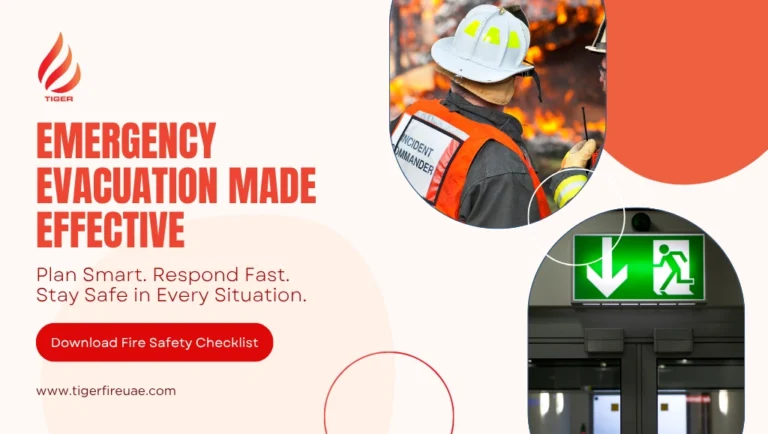Introduction
When an emergency strikes — be it a fire, explosion, or chemical leak — every second counts. The difference between chaos and safety often lies in one crucial element: a well-structured emergency evacuation plan.
In the UAE, where high-rise offices, malls, and industrial facilities dominate the skyline, ensuring a smooth evacuation process is not just good practice — it’s a legal and moral responsibility.
This blog provides a complete guide to emergency evacuation planning in UAE commercial buildings, outlining best practices that align with Civil Defense regulations and modern fire safety standards.
Why Emergency Evacuation Planning Matters
A well-designed evacuation plan ensures that all occupants can exit a building quickly, safely, and without panic during emergencies.
In the UAE, Civil Defense authorities mandate that all commercial and high-occupancy buildings must have approved evacuation procedures, signage, and trained personnel ready for quick response.
Key reasons why it’s essential:
Protects lives: Minimizes risk of injury or death during fire or emergency.
Ensures compliance: Meets UAE Civil Defense Fire & Life Safety Code.
Prevents chaos: Reduces panic and confusion during evacuation.
Supports first responders: Ensures easy access and communication with fire teams.
Safeguards reputation: A well-prepared business demonstrates professionalism and care for employee safety.
UAE Fire & Life Safety Code: What You Need to Know
The UAE Fire and Life Safety Code of Practice (2024 edition) provides clear requirements for emergency evacuation in all commercial, residential, and industrial buildings.
According to the Code:
Buildings must have clearly marked emergency exits.
Evacuation plans should be displayed prominently on every floor.
Fire alarms, voice evacuation systems, and emergency lighting must be maintained regularly.
Evacuation drills should be conducted at least twice a year.
Failure to comply can result in fines, business closure, or loss of Civil Defense certification.
Partnering with a fire safety company like Tiger Fire UAE ensures your building meets these standards seamlessly.
Key Components of an Effective Emergency Evacuation Plan
A professional evacuation plan includes both physical infrastructure and procedural preparedness. Here are the key elements every UAE commercial site must have:
1. Evacuation Routes & Exits
Every floor must have at least two unobstructed exit routes, clearly illuminated and marked with glow-in-the-dark signage. Routes should lead directly to a safe assembly area.
2. Fire Detection & Alarm Systems
Automatic fire alarms, smoke detectors, and public address systems are essential for alerting occupants. Systems must be audible and visible to all, including persons with disabilities.
3. Emergency Lighting
During a power outage, backup lighting ensures corridors, staircases, and exit signs remain visible for safe navigation.
4. Assembly Points
A designated outdoor space far from the building must be assigned for people to gather and undergo headcounts.
5. Evacuation Maps
Plans showing escape routes, fire extinguishers, and assembly points must be posted at every entrance, lift lobby, and corridor intersection.
6. Emergency Response Team (ERT)
Designate trained wardens on each floor to coordinate evacuations, assist those with limited mobility, and communicate with first responders.
7. Communication System
Integrate your fire alarm with voice announcements for real-time instructions and emergency updates.
Fire Safety Systems Supporting Evacuation
Having a clear plan is only effective when paired with robust fire protection systems.
UAE commercial buildings typically rely on:
Fire alarm & detection systems
Sprinkler and suppression systems
Fire-rated doors and smoke barriers
Emergency exit lighting
Fire pumps and hydrants
Tiger Fire UAE provides Civil Defense-approved fire systems that enhance your evacuation safety. Proper system maintenance ensures alerts and suppression activate automatically when required.
Steps to Develop an Emergency Evacuation Plan in 2025
Creating an effective emergency evacuation plan for UAE buildings involves strategic planning and regular updates.
Step 1: Risk Assessment
Identify all possible emergencies — fires, electrical failures, gas leaks, or natural hazards. Map out vulnerable areas and key risk points.
Step 2: Define Evacuation Procedures
Set procedures for:
Raising alarms
Alerting building occupants
Guiding evacuation through designated routes
Conducting headcounts at assembly points
Step 3: Design the Layout
Collaborate with certified fire safety consultants to mark exits, stairwells, and routes on detailed floor plans as per UAE standards.
Step 4: Install Fire Safety Equipment
Ensure your facility has functioning:
Fire alarms
Extinguishers
Sprinklers
Emergency lighting
Exit signage
Step 5: Train Employees & Tenants
Conduct regular fire drills and briefings to familiarize occupants with evacuation procedures.
Step 6: Periodic Testing & Updates
Evacuation plans should be reviewed every 6–12 months or after any structural changes in the building.
The Role of Fire Safety Partners in Evacuation Planning
Working with an experienced fire protection company makes a huge difference in how well your building handles emergencies.
At Tiger Fire UAE, we assist commercial property managers with:
Fire safety audits and evacuation design
Installation of alarms, sprinklers, and exit lighting
Civil Defense documentation and approvals
Staff training and annual evacuation planning
Our end-to-end support ensures every building meets UAE Fire & Life Safety Code standards with zero compromise on protection.
Conclusion
An emergency evacuation plan is not just paperwork — it’s a vital, life-saving strategy. In a country like the UAE, where commercial buildings and high-rises are integral to daily life, emergency evacuation planning in UAE sites must be treated with utmost seriousness.
By integrating technology, compliance, and employee awareness, building managers can ensure safe, efficient evacuation processes in any situation.
Partnering with Tiger Fire UAE, one of the UAE’s trusted fire protection companies, ensures that your evacuation plans, fire systems, and staff training meet the highest Civil Defense and NFPA standards — securing both people and property.

